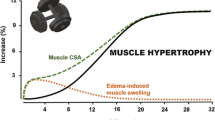Abstract
The extent and stability of the expression of developmental isoforms of myosin heavy chain (MHCd), and their association with cellular morphology, were determined in adult rat skeletal muscle fibres following injury induced by eccentrically-biased exercise. Adult female Wistar rats [274 (10) g] were either assigned as non-exercised controls or subjected to 30 min of treadmill exercise (grade, −16°; speed, 15 m · min−1), and then sacrificed following 1, 2, 4, 7, or 12 days of recovery (n = 5–6 per group). Histologically and immunohistologically stained serial, transverse cryosections of the soleus (S), vastus intermedius (VI), and tibialis anterior (TA) muscles were examined using light microscopy and digital imaging. Fibres staining positively for MHCd (MHCd+) were seldom detected in the TA. In the VI and S, higher proportions of MHCd+ fibres (0.8% and 2.5%, respectively) were observed in rats at 4 and 7 days post-exercise, in comparison to all other groups combined (0.2%, 1.2%; P ≤ 0.01). In S, MHCd+ fibres were observed less frequently by 12 days (0.7%) than at 7 days (2.6%) following exercise. The majority (85.1%) of the MHCd+ fibres had morphological characteristics indicative of either damage, degeneration, repair or regeneration. Most of the MHCd+ fibres also expressed adult slow, and/or fast myosin heavy chain. Quantitatively, the MHCd+ fibres were smaller (<2500 μm2) and more angular than fibres not expressing MHCd. Thus, there was a transient increase in a small, but distinct population of MHCd+ fibres following unaccustomed, functional exercise in adult rat S and VI muscles. The observed close coupling of MHCd expression with morphological changes within muscle fibres suggests that these characteristics have a common, initial exercise-induced injury-related stimulus.
Similar content being viewed by others
Author information
Authors and Affiliations
Additional information
Accepted: 25 January 1999
Rights and permissions
About this article
Cite this article
Smith, H., Plyley, M., Rodgers, C. et al. Expression of developmental myosin and morphological characteristics in adult rat skeletal muscle following exercise-induced injury. Eur J Appl Physiol 80, 84–91 (1999). https://doi.org/10.1007/s004210050562
Issue Date:
DOI: https://doi.org/10.1007/s004210050562




